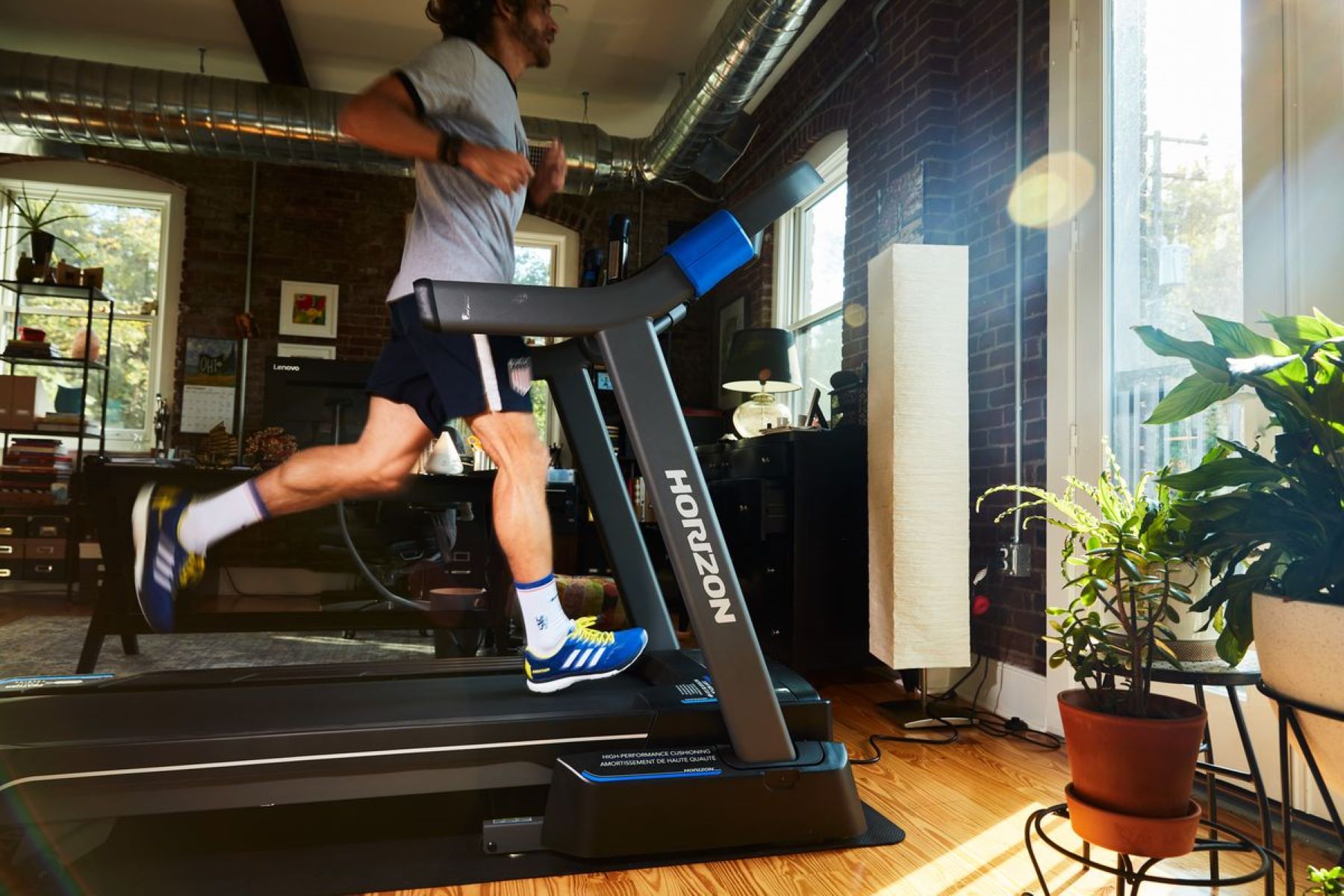

Featured
What Is Sprint Exercise
Modified: October 26, 2023
Discover the benefits of sprint exercises and how they can help you achieve your fitness goals. Find out how to incorporate featured sprint workouts into your routine for maximum results.
Introduction
Sprint exercise is a high-intensity training technique that has gained popularity among fitness enthusiasts and athletes. It involves short bursts of maximum effort followed by brief periods of rest or active recovery. Sprint exercises are not only an effective way to improve cardiovascular fitness, but they also provide numerous benefits for overall health and athletic performance.
Whether you’re a seasoned athlete looking to enhance your performance or simply someone looking to spice up your fitness routine, incorporating sprint exercises can take your workouts to the next level. In this article, we will explore the definition of sprint exercise, the benefits it offers, different types of sprint exercises, and how to incorporate them into your fitness regimen.
Before delving into the specifics, it is important to note that sprint exercises are not limited to running. While running sprints are the most common form of sprint exercise, they can also be performed on a bike, in the pool, or even on a rowing machine. The principle remains the same – giving maximum effort for a short period of time.
The allure of sprint exercise lies in its efficiency. Unlike long, steady-state workouts, sprint exercises provide a powerful stimulus to both the cardiovascular system and muscular strength. In just a fraction of the time, sprint exercises can yield significant results.
Furthermore, sprint exercises offer a variety of benefits, making them appealing to individuals with different fitness goals. From burning calories and improving endurance to building lean muscle and boosting metabolism, the advantages of sprint exercises are extensive and diverse.
In the following sections, we will explore the different types of sprint exercises, provide tips for proper sprinting technique, and discuss precautions and safety measures to ensure a safe and effective workout. Additionally, we will outline a sample sprint workout routine that you can incorporate into your fitness regimen.
So, are you ready to take your fitness to new heights? Let’s dive into the world of sprint exercises and discover the incredible benefits they have to offer.
Definition of Sprint Exercise
Sprint exercise is a form of high-intensity interval training (HIIT) that involves short bursts of maximum effort followed by brief periods of rest or active recovery. It is characterized by performing an activity at or near maximum capacity for a short duration, typically ranging from 5 to 30 seconds.
The key element of sprint exercise is the intensity of effort. It requires pushing yourself to your limits and exerting maximal force during each sprint interval. This intense effort stimulates your cardiovascular system, increases metabolism, and triggers numerous physiological adaptations that can lead to enhanced athletic performance and improved overall fitness.
During a sprint exercise, the body utilizes the anaerobic energy system, relying mainly on stored energy reserves in the muscles rather than oxygen from breathing. This leads to a rapid depletion of energy stores, which triggers the body to adapt and become more efficient at producing and utilizing energy.
One of the defining characteristics of sprint exercise is the duration of each sprint interval. Unlike traditional endurance exercises such as jogging or steady-state cardio, where you may perform the activity for an extended period, sprint intervals are performed at maximum effort for a short time frame.
While there is no set time duration for a sprint exercise, it is generally agreed that the interval should be intense enough that sustaining the effort for longer than 30 seconds becomes challenging. The intensity can vary depending on factors such as fitness level, the type of exercise, and personal goals.
Sprint exercise is versatile and can be adapted to various forms of physical activity. Running sprints are the most common and straightforward form of sprint exercise, but cycling, swimming, rowing, and even bodyweight exercises can all be performed as sprints. The key is to choose an activity that allows you to generate maximum effort within a short time frame.
It is worth noting that sprint exercise is not suitable for everyone. Individuals with certain health conditions or injuries may need to consult with a healthcare professional or exercise specialist before incorporating sprint exercises into their routine. Additionally, beginners or those who have been sedentary for a long time should start with caution and gradually increase the intensity and duration of sprint intervals.
Now that we have defined sprint exercise and its key components, let’s explore the numerous benefits it brings to the table.
Benefits of Sprint Exercise
Sprint exercise offers a wide range of benefits for both physical fitness and overall health. Incorporating sprint exercises into your fitness routine can lead to improvements in cardiovascular endurance, muscular strength, body composition, and metabolic function. Here are some of the key benefits:
- Increased calorie burn: Sprint exercise is highly effective in burning calories. The intense effort and increased heart rate during sprint intervals result in a higher caloric expenditure, even after the workout is over. This can contribute to weight loss or maintenance.
- Improved cardiovascular endurance: Sprint exercise challenges the cardiovascular system and enhances its capacity by increasing heart rate, oxygen uptake, and stroke volume. Regular sprinting can improve cardiovascular endurance, allowing you to perform activities for longer without fatigue.
- Enhanced muscle tone and strength: Sprint exercise engages multiple muscle groups and stimulates muscle growth and development. The explosive movements involved in sprinting activate fast-twitch muscle fibers, leading to improved muscle tone, strength, and power.
- Boosted metabolism: The intense nature of sprint exercise stimulates a phenomenon known as excess post-exercise oxygen consumption (EPOC). This means that your body continues to burn calories at an elevated rate even after the workout, as it works to restore oxygen levels and repair damaged tissues.
- Improved insulin sensitivity: Sprint exercise has been shown to enhance insulin sensitivity, which helps regulate blood sugar levels. This can be particularly beneficial for individuals with type 2 diabetes or those at risk of developing it.
- Increased human growth hormone (HGH) production: Sprint exercise has been linked to an increase in the production of HGH, which plays a crucial role in muscle growth, repair, and overall health. Higher levels of HGH can lead to improved body composition and faster recovery.
- Elevated mood and mental well-being: Engaging in sprint exercise releases endorphins, which are known as the “feel-good” hormones. These hormones can help reduce stress, elevate mood, and improve mental well-being.
- Time efficiency: Sprint exercise offers a time-efficient way to improve fitness compared to longer, steady-state workouts. With shorter, intense intervals, you can achieve significant results in a fraction of the time.
These are just a few of the many benefits that sprint exercise offers. Whether you’re aiming to lose weight, improve athletic performance, or simply enhance your overall health, incorporating sprint exercises into your routine can help you achieve your goals more efficiently.
Now that we have explored the benefits of sprint exercise, let’s dive into the different types of sprint exercises you can incorporate into your fitness regimen.
Types of Sprint Exercises
Sprint exercises are not limited to running. While running sprints are the most common and straightforward form, sprint exercises can be performed using various activities and equipment. Here are some of the different types of sprint exercises:
- Running sprints: Running sprints involve sprinting at maximum effort for a short distance, followed by a period of rest or active recovery. This could be done on a track, field, or any open space suitable for running.
- Hill sprints: Hill sprints are similar to running sprints but with the added challenge of sprinting uphill. The incline adds resistance, making it more demanding and effective for building lower body strength and power.
- Cycling sprints: Cycling sprints can be performed on a stationary bike or outdoors. This involves pedaling at maximum effort for a short duration, followed by a period of rest or easy pedaling. This type of sprint exercise is low-impact, making it suitable for individuals with joint issues or injuries.
- Swimming sprints: Swimming sprints are an excellent full-body workout. They involve swimming at maximum effort for a short distance, followed by a period of rest or easy swimming. Swimming sprints improve cardiovascular endurance, muscular strength, and lung capacity.
- Rowing sprints: Rowing sprints can be performed using a rowing machine or an actual rowboat. This type of sprint exercise engages both the upper and lower body, targeting the back, arms, and legs. Rowing sprints improve strength, endurance, and cardiovascular fitness.
- Bodyweight sprints: Bodyweight sprints utilize exercises such as burpees, jumping jacks, or high knees to elevate the heart rate and engage multiple muscle groups. These exercises can be performed in quick succession, with short rest periods in between.
- Team sport sprints: Sprint exercises are also commonly incorporated into team sports training. Sports like soccer, basketball, and rugby involve short bursts of maximal effort followed by active recovery or rest. These sprint intervals mimic the demands of the game and help improve agility, speed, and stamina.
These are just a few examples of the types of sprint exercises available. The choice of sprint exercise depends on your preference, fitness level, and the equipment or facilities available to you. Remember to choose an activity that allows you to exert maximum effort within a short time frame.
Now that you have an understanding of the different types of sprint exercises, let’s move on to how you can incorporate them into your fitness routine.
How to Incorporate Sprint Exercises into Your Fitness Routine
Incorporating sprint exercises into your fitness routine is a great way to add variety and intensity to your workouts. Here are some tips on how to effectively include sprint exercises in your routine:
- Warm up: Before starting any sprint exercises, it is crucial to properly warm up your body with dynamic stretches, light jogging, or mobility exercises. This helps prepare your muscles, joints, and cardiovascular system for the intense effort of sprinting.
- Start with shorter intervals: If you are new to sprint exercises or have been sedentary for a while, it is important to start gradually. Begin with shorter sprint intervals, such as 10-15 seconds, and longer rest periods. As you build stamina and fitness, gradually increase the duration and intensity of your sprint intervals.
- Use a timer or stopwatch: To ensure that you are sprinting at maximum effort and maintaining consistent intervals, use a timer or stopwatch to time your sprints. This will help you track your progress and push yourself to improve over time.
- Mix up the distances and intensities: Experiment with different distances and intensities to keep your workouts challenging and engaging. You can include shorter sprints for maximum speed and power, as well as longer sprints for endurance. Mixing up the distances will help improve different aspects of your fitness.
- Incorporate rest or active recovery: After each sprint interval, make sure to include a period of rest or active recovery. This can be walking, jogging lightly, or performing low-intensity exercises. Giving your body time to recover will allow you to maintain the intensity of each sprint interval.
- Combine sprint exercises with other forms of training: To create a well-rounded fitness routine, combine sprint exercises with other forms of training. This can include strength training, flexibility exercises, or steady-state cardio workouts. By incorporating a variety of exercises, you will work different muscle groups and improve overall fitness.
- Progress gradually: As you become fitter and more accustomed to sprint exercises, gradually increase the duration and intensity of your sprint intervals. This progressive overload helps you continue challenging your body and making progress over time.
- Listen to your body: Pay attention to your body’s feedback during sprint exercises. If you experience any pain, discomfort, or unusual fatigue, it is important to listen to your body and rest as needed. Pushing through excessive fatigue or pain can lead to injuries.
Remember to always consult with a fitness professional before starting a new exercise routine, especially if you have any health concerns or pre-existing conditions. They can provide guidance and tailor a sprint exercise program to suit your individual needs and goals.
Now that you have an idea of how to incorporate sprint exercises into your fitness routine, let’s explore some tips for maintaining proper sprinting technique.
Tips for Proper Sprinting Technique
Proper sprinting technique is essential to maximize the benefits of sprint exercises and reduce the risk of injury. Here are some tips to help you maintain proper form and technique while sprinting:
- Start with a good warm-up: Before sprinting, it is important to warm up your muscles and joints to increase blood flow and flexibility. Incorporate dynamic stretches and mobility exercises to prepare your body for the intense effort.
- Maintain an upright posture: Keep your head up, shoulders relaxed, and chest slightly forward to maintain an upright posture. Avoid leaning too far forward or backward, as this can affect your balance and stride efficiency.
- Engage your core: Activate your core muscles by drawing your belly button towards your spine. This helps stabilize your torso and maintain proper alignment throughout the sprint.
- Drive your knees: Focus on lifting your knees while sprinting. This helps to generate more power and propel you forward. Ensure that your knee drive is forward and not excessively upward.
- Push off with your toes: As your foot strikes the ground, push off forcefully with the balls of your feet. This helps generate power and maintain a quick cadence. Avoid landing on your heels, as this can slow you down and increase the risk of injury.
- Swing your arms: Coordinate your arm movement with your leg stride. Bend your elbows at approximately 90 degrees and swing them forward and backward in a relaxed yet controlled manner. This reciprocal action helps to maintain balance and generate momentum.
- Breathe rhythmically: Focus on maintaining a steady breathing pattern by inhaling through your nose and exhaling through your mouth. This helps deliver sufficient oxygen to your muscles and improves endurance.
- Gradually increase stride length: As you become more comfortable with sprinting, work on gradually increasing your stride length. This can help you cover more ground with each step and improve your speed.
- Take adequate rest: Allow yourself sufficient rest between sprint intervals to recover and maintain proper form throughout each sprint. This will help you maintain speed and technique without compromising form due to fatigue.
- Listen to your body: Pay attention to any signs of pain, discomfort, or excessive fatigue. If you experience any of these, it is important to listen to your body and adjust your intensity or seek professional guidance.
Remember to start slowly and gradually increase your speed and intensity as you become more comfortable and proficient in sprinting. Practicing proper sprinting technique will not only maximize the benefits of sprint exercises but also reduce the risk of injury.
As we conclude the tips for sprinting technique, let’s move on to the precautions and safety measures you should keep in mind when performing sprint exercises.
Precautions and Safety Measures for Sprint Exercises
While sprint exercises can be highly beneficial for your fitness and overall health, it is important to take certain precautions and adhere to safety measures to minimize the risk of injury. Here are some precautions to consider when incorporating sprint exercises into your fitness routine:
- Consult with a healthcare professional: If you have any pre-existing medical conditions, injuries, or concerns, it is advisable to consult with a healthcare professional before starting sprint exercises. They can provide guidance on your fitness readiness and any modifications you may need.
- Proper warm-up and cool-down: Always warm up your body before engaging in sprint exercises. Perform dynamic stretches and movements to prepare your muscles and joints. Similarly, cool down with some light exercise or stretching to gradually bring your heart rate down.
- Progress gradually: Avoid diving into high-intensity sprint exercises without building a foundation. Start with shorter distances and slower speeds, gradually increasing the duration and intensity of your sprints over time.
- Select appropriate footwear: Choose shoes that offer proper support and cushioning for your feet. This will help absorb shock and minimize the risk of foot, ankle, or knee injuries.
- Pay attention to surfaces: Be mindful of the surfaces you sprint on. Opt for even and non-slippery surfaces to reduce the risk of tripping or slipping. Avoid uneven or rough terrain that may increase the chances of sprains or strains.
- Listen to your body: Tune in to any pain, discomfort, or signs of fatigue during sprint exercises. Pushing through excessive pain or fatigue can lead to injury. Take rest and recover as needed, and modify the intensity or duration of your sprints accordingly.
- Hydrate adequately: Stay hydrated before, during, and after your sprint exercises. Dehydration can affect your performance, endurance, and overall well-being. Drink water or electrolyte-rich fluids to replenish lost fluids.
- Consider weather conditions: Adjust your sprint exercises based on weather conditions. Avoid extreme heat or cold, and be mindful of slippery surfaces in rainy or snowy conditions. Dress appropriately and protect yourself from extreme weather elements.
- Seek guidance: If you are new to sprint exercises or unsure about proper technique, consider seeking guidance from a fitness professional. They can provide you with proper instruction, feedback, and personalized training plans to mitigate the risk of injury.
- Listen to your body: Each individual’s fitness level and capabilities are unique. It is important to listen to your body and respect its limits. Pushing yourself too hard or comparing yourself to others may lead to overexertion, fatigue, and injury.
By following these precautions and safety measures, you can enjoy the benefits of sprint exercises while minimizing the risk of injury. Remember that your safety and well-being are priorities, so always prioritize proper technique, warm-up, and care for your body.
Now that we have covered the precautions and safety measures, let’s move on to a sample sprint workout routine to help you incorporate sprint exercises into your fitness regimen.
Sample Sprint Workout Routine
Here is a sample sprint workout routine that you can incorporate into your fitness regimen. Remember to adjust the intensity and duration based on your fitness level and goals:
- Warm-up: Begin with a 5-10 minute warm-up that includes light jogging, dynamic stretches, and mobility exercises.
- Sprint Intervals: Perform the following sprint intervals at maximum effort, followed by a rest or active recovery period:
- – 10 seconds sprint, followed by 30 seconds walk or rest
- – 20 seconds sprint, followed by 40 seconds walk or rest
- – 30 seconds sprint, followed by 60 seconds walk or rest
- – 20 seconds sprint, followed by 40 seconds walk or rest
- – 10 seconds sprint, followed by 30 seconds walk or rest
- Cool-down: Finish the workout with a 5-10 minute cool-down, including light jogging and static stretches for major muscle groups.
This sample sprint workout routine incorporates different intervals to challenge your body and build endurance. As you progress, feel free to adjust the duration and intensity of the sprint intervals to suit your fitness level and goals.
Remember to listen to your body throughout the workout. Modify the intensity or take additional rest as needed. It is crucial to prioritize safety and avoid pushing beyond your limits, especially when starting or progressing with sprint exercises.
Additionally, you can customize this workout routine by incorporating different types of sprint exercises, such as cycling sprints, hill sprints, or swimming sprints. The key is to choose exercises that you enjoy and that allow you to generate maximum effort within a short time frame.
Consult with a fitness professional to tailor a sprint workout routine specifically for your fitness level, goals, and any individual considerations you may have.
Now that we have covered a sample sprint workout routine, it’s time to wrap up this article. By incorporating sprint exercises into your fitness routine, you can enjoy the numerous benefits they offer and take your fitness to the next level.
Conclusion
Sprint exercise is a dynamic and effective training technique that offers a multitude of benefits for overall fitness and health. Whether you’re a seasoned athlete or a beginner looking to spice up your fitness routine, incorporating sprint exercises can help you achieve your fitness goals more efficiently.
In this article, we explored the definition of sprint exercise, the benefits it provides, and the various types of sprint exercises you can incorporate into your fitness routine. We also discussed the importance of proper sprinting technique, precautions, and safety measures to minimize the risk of injury.
Sprint exercises offer numerous benefits, including increased calorie burn, improved cardiovascular endurance, enhanced muscle tone and strength, and boosted metabolism. They are time-efficient and versatile, allowing you to incorporate them into various forms of physical activity.
When incorporating sprint exercises into your fitness routine, it is essential to warm up properly, gradually increase the intensity and duration, and listen to your body. Taking the necessary precautions and seeking professional guidance can help ensure that you have a safe and effective sprinting experience.
With a sample sprint workout routine provided, you can tailor it to your fitness level and preferences. Remember to adjust the duration, intensity, and rest periods to challenge yourself while maintaining proper form and minimizing the risk of injury.
So, are you ready to take your fitness to new heights? Incorporate sprint exercises into your routine and enjoy the benefits of improved cardiovascular fitness, increased calorie burn, and enhanced muscular strength. Stay consistent, push your limits, and strive for progress, all while prioritizing your safety and well-being.
Now, go out there and sprint your way to a fitter, healthier, and stronger you!








